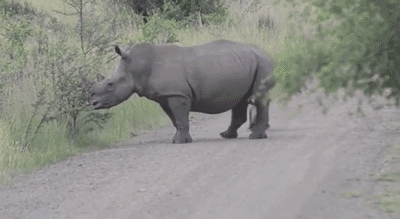Do you remember your early visits to the zoo as children?Out of all animals, one that was particularly fascinating was the rhinoceros.
Huge, armored beings with a unicorn-like horn, extremely powerful, yet gentle herbivores, they looked like the direct descendants of dinosaurs.
Rhinoceros are the second largest mammals in the world. Characterized by their size, their extremely hard, protective skin (1.5–5 cm thick) and large horn, they are one of the most sought after species among poachers.
In all, there are five species of rhino in the world: Black, white, greater one-horned, Sumatran and Javan rhinos. But sadly, out of these five, three of the species are critically endangered.

Why poachers kill Rhinos?
Rhinos are hunted for their priceless horn. Unlike other horned mammals whose horns have a bony core, the horns of rhinos are made of keratin, like human nails.
These horns have been used in the traditional medicinal practices of Europe and Asia, especially as cancer cure!
But incidentally, these medicinal practices are not even scientifically supported.
Then there is the ornamental use of horns! It is used to make traditional dagger handles in places like Yemen and Oman.
Even worse, in Vietnam, powdered horn is inhaled as status symbol!
All these reasons show, not the usefulness of the horn, but point out the human selfishness and greed! These flimsy reasons are fulfilled at the price of life.
Not just of the rhinos, but people as well! According to Sean Willmore, President of the International Ranger Federation, worldwide, poachers murder more than two park rangers per week.
And sadly, 2012 saw the extinction of the Vietnamese Javan Rhinoceros to poachers. Now there are only 60 of this specific specie left surviving in Ujung Kulon National Park in Java, Indonesia.
Situation in India
Unfortunately, India is also seeing a definite rise in the Rhino poaching activities. The number of rhinoceros poached in India reached 27 in 2014, from 5 in 2006.
Apart from poaching, other factors such as habitat destruction, human or livestock encroachment and climatic changes, are resulting into these dwindling numbers.
India is home to almost 95% of the One-horned Rhinos in the grasslands of Assam, majorly Kaziranga and Pobitora. The other surviving members are in the Terai grasslands of southern Nepal, northern Uttar Pradesh, northern Bihar, northern Bengal, and in the Brahmaputra Valley of Assam.
Why save Rhinos?
Rhinos are classified as grazers, and by selectively eating certain kinds of plants over others, increase biodiversity.
They are an intrinsic part of the delicate balance of the ecosystem. Their extinction may have hugely negative impact in the world.
Efforts for conservation
In 2010, WWF South Africa first brought attention to the plight of these creatures.
They announced September 22 as the World Rhino Day, to increase awareness not only about this endangered species, but also the dangers of poaching and habitat loss.
Since the catastrophe of 2012, efforts have increased to control and stop the poachers.WWF is tirelessly working with various governments to prevent illegal poaching and horn trade. TRAFFIC,
the world’s largest wildlife trade monitoring network, has developed innovative new transmitters to track rhino movements.
They are also working to prevent forest conversion and restore their natural habitat.
Under the Rhino Rescue project, the horns of live rhinos was infused with pink dye and acaricide to render them useless and toxic for human consumption.
Acaricide, in itself, acts as a tick repellant on the animal.
Even the army veterans have joined the movement. A number of US military veterans have relocated to Africa to work for Veterans Empowered to Protect African Wildlife (VETPAW), an organization that works with park rangers, training them in marksmanship, field medicine and maneuvering at night.
What you can do?
- Write to us and share your idea to spread awareness about the same and other causes! One cannot emphasize enough how important this is. We all need to be the change we want to see in this world.
- Tomorrow, instead of the usual party, do something meaningful! Use the money to start a fundraiser in collaboration with WWF or donate to an existing campaign.
- Addicted to sports and marathons and the adrenaline rush? Why not participate in these featured events to show your support!
Apart from WWF, you can contact any of the following organizations and understand how you can support this cause.
- International Rhino Foundation
- The Kariega Foundation – Save the Rhino
- Save the Rhino International
- Project Rhino KZN
- SANParks Honorary Rangers
The time is here! We must focus all our energies into conservation of this planet and its beings!
Lest it be too late and we don’t even survive to rue the consequences of our own actions!





You must be logged in to post a comment.